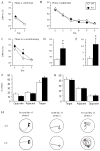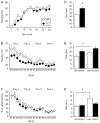Zinc transporter ZnT3 is involved in memory dependent on the hippocampus and perirhinal cortex
- PMID: 21545813
- PMCID: PMC3111813
- DOI: 10.1016/j.bbr.2011.04.020
Zinc transporter ZnT3 is involved in memory dependent on the hippocampus and perirhinal cortex
Abstract
Since zinc transporter ZnT3 is localized to the hippocampus and perirhinal cortex, we used ZnT3 knockout mice (KO) to analyze the role of ZnT3 in memory and behavior dependent on these brain regions. ZnT3KO mice were normal in initial learning in the standard water maze but had difficulty finding a second platform location. The mutants showed increased social interaction but were deficient in social and object recognition memory. These data suggest that ZnT3 is involved in certain types of spatial memory and behavior dependent on the hippocampus and perirhinal cortex.
Copyright © 2011 Elsevier B.V. All rights reserved.
Figures



Similar articles
-
Zinc transporter ZnT-3 regulates presynaptic Erk1/2 signaling and hippocampus-dependent memory.Proc Natl Acad Sci U S A. 2011 Feb 22;108(8):3366-70. doi: 10.1073/pnas.1019166108. Epub 2011 Jan 18. Proc Natl Acad Sci U S A. 2011. PMID: 21245308 Free PMC article.
-
Zinc transporter 3 is involved in learned fear and extinction, but not in innate fear.Learn Mem. 2010 Oct 29;17(11):582-90. doi: 10.1101/lm.1962010. Print 2010 Nov. Learn Mem. 2010. PMID: 21036893 Free PMC article.
-
Behavioral characterization of female zinc transporter 3 (ZnT3) knockout mice.Behav Brain Res. 2017 Mar 15;321:36-49. doi: 10.1016/j.bbr.2016.12.028. Epub 2016 Dec 21. Behav Brain Res. 2017. PMID: 28012850
-
Contrasting hippocampal and perirhinal cortex function using immediate early gene imaging.Q J Exp Psychol B. 2005 Jul-Oct;58(3-4):218-33. doi: 10.1080/02724990444000131. Q J Exp Psychol B. 2005. PMID: 16194966 Review.
-
When is the perirhinal cortex necessary for the performance of spatial memory tasks?Neurosci Biobehav Rev. 2004 Oct;28(6):611-24. doi: 10.1016/j.neubiorev.2004.08.007. Neurosci Biobehav Rev. 2004. PMID: 15527866 Review.
Cited by
-
Synaptic Zn2+ inhibits neurotransmitter release by promoting endocannabinoid synthesis.J Neurosci. 2013 May 29;33(22):9259-72. doi: 10.1523/JNEUROSCI.0237-13.2013. J Neurosci. 2013. PMID: 23719795 Free PMC article.
-
The neurophysiology and pathology of brain zinc.J Neurosci. 2011 Nov 9;31(45):16076-85. doi: 10.1523/JNEUROSCI.3454-11.2011. J Neurosci. 2011. PMID: 22072659 Free PMC article. Review.
-
Chelators for investigating zinc metalloneurochemistry.Curr Opin Chem Biol. 2013 Apr;17(2):129-36. doi: 10.1016/j.cbpa.2013.01.009. Epub 2013 Mar 13. Curr Opin Chem Biol. 2013. PMID: 23478014 Free PMC article. Review.
-
Modulation of neuronal signal transduction and memory formation by synaptic zinc.Front Behav Neurosci. 2011 Nov 9;5:68. doi: 10.3389/fnbeh.2011.00068. eCollection 2011. Front Behav Neurosci. 2011. PMID: 22084630 Free PMC article.
-
Synaptic zinc potentiates AMPA receptor function in mouse auditory cortex.Cell Rep. 2023 Aug 29;42(8):112932. doi: 10.1016/j.celrep.2023.112932. Epub 2023 Aug 15. Cell Rep. 2023. PMID: 37585291 Free PMC article.
References
Publication types
MeSH terms
Substances
Grants and funding
LinkOut - more resources
Full Text Sources
Medical
Molecular Biology Databases
Research Materials

